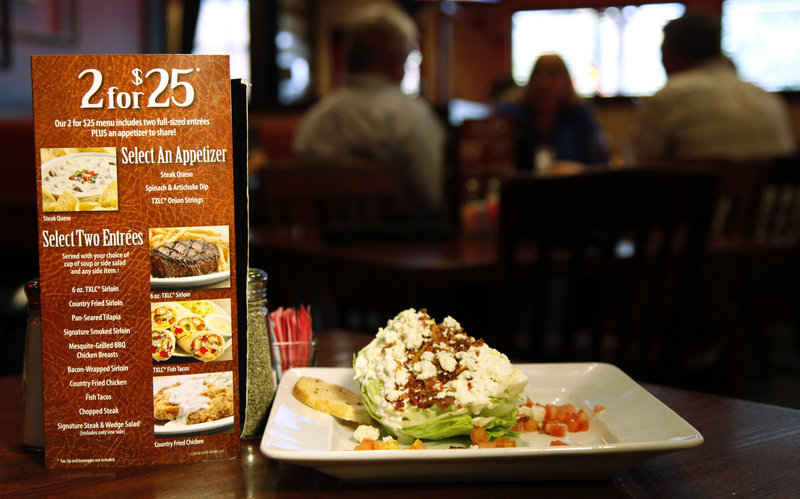DALLAS – At Texas Land & Cattle Steak House, the plan was simple: During the slack months of February and March, the chain would field a limited-time offer — two entrees and a shared appetizer for $25.
Nine months later, the deal is still on the table. And it’ll most likely be there next year because consumers aren’t eager to let go. “Ten to 15 percent of our total sales mix is people that are buying two for $25,” said Howard Terry, vice president of marketing for the casual dining chain owned by Dallas-based Lone Star Funds. “It was so popular we couldn’t take it away.”
With margins strained by months of deep discounts, consumer-centric businesses are looking to wean the public off the addicting deals that kept them coming during the recession.
They concede it won’t be easy — or quick. Some areas may take longer to recover than the five years needed after Sept. 11, 2001, experts said. The key challenge, they said, is to get consumers focused less on rock-bottom prices and more on value.
“Consumers are going to be more conscious of how they spend their money, and they’re going to spend it where they think they get the most value,” said Wyman Roberts, president of Chili’s Grill & Bar, which has its own two-for-$20 special.
“There are other ways to provide value than just price,” he said. “And that’s what we’re focused on. At the same time, we understand it’s tough out there. We’ve still got to be competitive with pricing.”
During the protracted downturn, discounting became a mainstay for nearly every industry that depends on consumer dollars. Retailers continue to cut prices during this post-recession holiday season.
But some in the hospitality sector, fearful of further margin erosion, have said enough is enough.
In an analysts’ conference call last month, the chief executive of Grand Prairie, Texas-based Six Flags Entertainment Corp. likened deep discounting to “a drug” and said, “We are carefully reducing our dependence on high discounts to drive attendance.”
He said the company will focus on adding rides and attractions to draw crowds.
At a recent hotel industry conference, Thomas Corcoran Jr., chairman of real estate trust FelCor Lodging Trust Inc., allowed that consumers love discounts. “The problem is,” he said, “the hotel has got to be able to make money.”
At the annual meeting last month of Brinker International Inc., the parent of Chili’s, Roberts said Chili’s saw a drop in traffic this summer when it replaced a sweeter deal — a shared appetizer, two entrees and a shared dessert for $20 — with the current offer, which drops dessert.
“But we also saw a significant improvement in earnings,” he said. “The margins that we were able to realize based on a different promotional mix flowed through” to the bottom line.
“It’s (finding) that balance of what’s the right thing for the guest and what’s the right thing from a business perspective,” he said.
During the downturn, the balance tipped decidedly in favor of consumers who retreated to their equity-starved homes, only coming out for bargain-basement prices.
“We’ve never seen a traffic decline of this magnitude, for this prolonged period of time, in all of the years of tracking,” said Bonnie Riggs, an analyst with NPD Group, a research firm that has studied the restaurant industry since 1976.
Per-capita restaurant visits fell 6 percent between the year that ended August 2008 and the year that ended August 2010, she said. “We saw declines on top of declines.”
Deals kept the industry from suffering steeper traffic declines, Riggs said. “Just about everyone did it. They had to.”
Among hotels, some of the deepest discounts were practically invisible to most consumers — done through “opaque sites” such as Priceline.com. Even the buyer doesn’t know which hotel is offering the discount until the room is paid for.
As hoteliers try to boost rates that fell 9 percent last year, fewer of those deals now exist, said Tim Sullivan, president of the North Texas Hotel Association.
“The big difference is the availability of the super-low discounts,” said Sullivan, contrasting late 2009, which often saw discounts of 25 percent, with today’s typical 15 percent price break. “I think the market is stabilizing.”
Send questions/comments to the editors.



Success. Please wait for the page to reload. If the page does not reload within 5 seconds, please refresh the page.
Enter your email and password to access comments.
Hi, to comment on stories you must . This profile is in addition to your subscription and website login.
Already have a commenting profile? .
Invalid username/password.
Please check your email to confirm and complete your registration.
Only subscribers are eligible to post comments. Please subscribe or login first for digital access. Here’s why.
Use the form below to reset your password. When you've submitted your account email, we will send an email with a reset code.